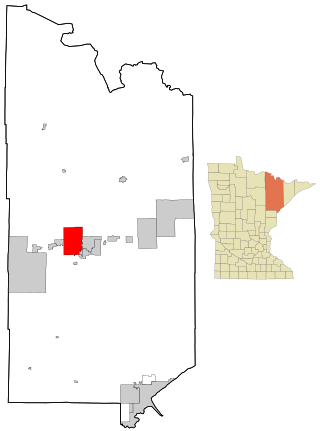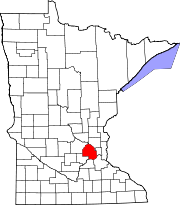Port Hope Township is a township in Beltrami County, Minnesota, United States. The population was 590 as of the 2000 census.

Taylor Township is a township in Beltrami County, Minnesota, United States. The population was 108 as of the 2000 census.
Turtle River Township is a township in Beltrami County, Minnesota, United States. The population was 1,085 as of the 2010 census.
Boy River Township is a township in Cass County, Minnesota, United States. The population was 100 as of the 2000 census. This township took its name from the Boy River.

Brooklyn Park is a suburban city on the west bank of the Mississippi River, upstream from downtown Minneapolis in northern Hennepin County. It is the sixth-largest city in the U.S. state of Minnesota. The population was 86,478 at the 2020 census. The city still has undeveloped land and farms, including the historic Eidem Homestead, a 1900s working farm that is a popular tourist attraction for families and school field trips. Brooklyn Park is considered both a second- and third-tier suburb of Minneapolis, because much of the land north of 85th Avenue was developed after 2000.

Crystal is a suburban city in Hennepin County, Minnesota, United States that is about 5 miles from Downtown Minneapolis. The population was 23,330 at the 2020 census. Minnesota State Highway 100 and County Road 81 are two of the main routes in the city.
Crystal Bay Township is a township in Lake County, Minnesota, United States. The population was 607 at the 2000 census.

Forest City Township is a township in Meeker County, Minnesota, United States. The population was 666 at the 2000 census. The unincorporated community of Forest City is located within Forest City Township.

Harding is a city in Morrison County, Minnesota, United States. The population was 123 at the 2020 census.

Dovray is a city in Murray County, Minnesota, United States. The population was 58 at the 2020 census.
Good Hope Township is a township in Norman County, Minnesota, United States. The population was 44 at the 2000 census.

McIntosh is a city in Polk County, Minnesota, United States. It is part of the Grand Forks, ND-MN Metropolitan Statistical Area. The population was 606 at the 2020 census.
Culver Township is a township in Saint Louis County, Minnesota, United States. The population was 294 at the 2010 census.
Fayal Township is an urban township in Saint Louis County, Minnesota, United States. The population was 1,809 at the 2010 census.

Mountain Iron is a city in Saint Louis County, Minnesota, United States, in the heart of the Mesabi Range. The population was 2,878 at the 2020 census.
Avon Township is a township in Stearns County, Minnesota, United States. The population was 2,294 at the 2010 census. The township includes the city of Avon.
Grove Township is a township in Stearns County, Minnesota, United States. The population was 493 at the 2010 census. The township includes the southern one-third of the City of Melrose and the City of Greenwald.
Millwood Township is a township in Stearns County, Minnesota, United States. The population was 972 at the 2010 census. The township includes the city of St. Rosa.

Robbinsdale is a city in Hennepin County, Minnesota, United States. The population was 13,953 at the time of the 2010 census. The city is located in the Minneapolis–Saint Paul metropolitan area and is adjacent to the northwest portion of Minneapolis.

Elkton is a city in Marshall Township, Mower County, Minnesota, United States. The population was 130 at the 2020 census.











